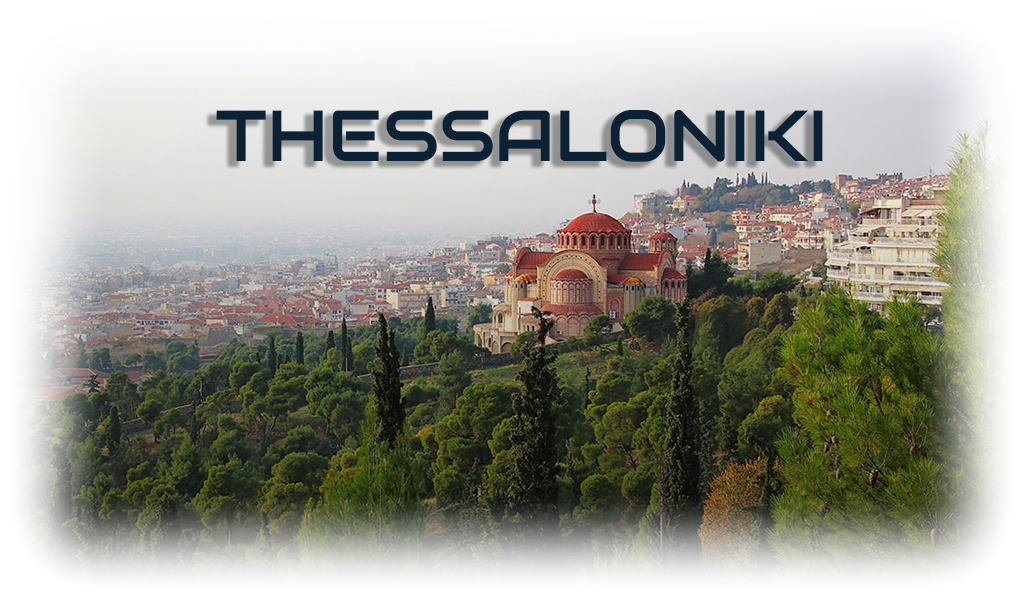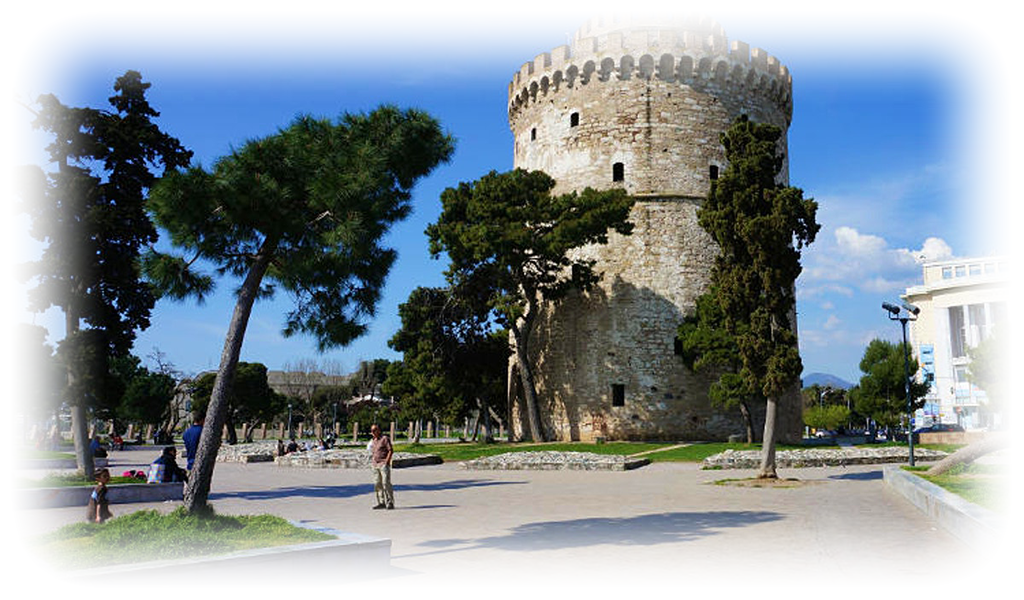
Thessaloniki(Greek: Θεσσαλονίκη) is the second most populous city in Greece, located in the north of the country in the historic region of Central Macedonia. It is the administrative center of the decentralized administration of Macedonia - Thrace and a major seaport. Thessaloniki is a beautiful city with a pleasant cosmopolitan atmosphere, where you can find many ancient monuments, admire the ancient Byzantine churches, listed as UNESCO World Heritage Sites, sit in cozy cafes and enjoy traditional Greek cuisine.
Thessaloniki is considered the cultural capital of Greece. The city is famous for its bright and rich cultural life. It is also home to the largest university in the Balkans, which attracts many young people. Thessaloniki is a city with a long and rich history. The appearance of the old city was formed by the ancient Greeks, Romans, Byzantines and Ottomans. Therefore, here you can see both ancient monuments of the ancient period and much more modern buildings.
Geography and weather
Thessaloniki is located on the northern outskirts of the Gulf of Thermaikos (Aegean Sea) and is bounded on the southeast by the Hortiatis Mountains. The climate is subtropical. Summer is quite hot and dry with average temperatures of 25 - 27 ° C. Winter is cool with rare negative temperatures. The water temperature in the sea from July to September is 24 - 26 ° C. You can swim from May to October.
History and interesting facts
Thessaloniki was founded in 315 BC. BC Macedonian King Cassandra. He named the city after his wife Thessalonica, who was the sister of Alexander the Great. In 146 BC. Thessaloniki was captured by the Romans. After the collapse of the Roman Empire, the city became part of Byzantium. Thessaloniki was at the crossroads of important trade routes from Constantinople to Rome and from Athens to the Black Sea. This provided the city with rapid growth and wealth.
In the 6-8th century Thessaloniki tried several times to take the Goths and Slavs. In 904, the city was captured and looted by Saracen Pirates. Most of the inhabitants were sold into slavery. At the end of the 10th century Thessaloniki was captured by the Bulgarians, and at the end of the 12th century by the Normans. In 1204 the city became the capital of the Kingdom of Thessaloniki. However, as early as 1246, this state was subordinated to the Nicaean Empire. In 1387 the city was captured by the Turks. The Ottomans ruled Thessaloniki until 1402, when after their defeat in the war with Tamerlane, the city returned to Byzantium.
In 1430 the Ottoman Empire regained control of the city. During the Ottoman rule, Thessaloniki became one of the largest cities in Greece. At the same time, the ethnic and religious composition has changed greatly. The Greek nobility assimilated with the Turks, learned the Turkish language and converted to Islam. More than half of the population were Spanish Jews. Ladino became the main language in the city. The Greeks were only 1/5 of the city's population. Most of them died during the military conflicts of the Middle Ages. Many Turks also lived in the city. Here, for example, the famous Mustafa Kemal Ataturk was born.
Thessaloniki is considered the cultural capital of Greece. The city is famous for its bright and rich cultural life. It is also home to the largest university in the Balkans, which attracts many young people. Thessaloniki is a city with a long and rich history. The appearance of the old city was formed by the ancient Greeks, Romans, Byzantines and Ottomans. Therefore, here you can see both ancient monuments of the ancient period and much more modern buildings.
Geography and weather
Thessaloniki is located on the northern outskirts of the Gulf of Thermaikos (Aegean Sea) and is bounded on the southeast by the Hortiatis Mountains. The climate is subtropical. Summer is quite hot and dry with average temperatures of 25 - 27 ° C. Winter is cool with rare negative temperatures. The water temperature in the sea from July to September is 24 - 26 ° C. You can swim from May to October.
History and interesting facts
Thessaloniki was founded in 315 BC. BC Macedonian King Cassandra. He named the city after his wife Thessalonica, who was the sister of Alexander the Great. In 146 BC. Thessaloniki was captured by the Romans. After the collapse of the Roman Empire, the city became part of Byzantium. Thessaloniki was at the crossroads of important trade routes from Constantinople to Rome and from Athens to the Black Sea. This provided the city with rapid growth and wealth.
In the 6-8th century Thessaloniki tried several times to take the Goths and Slavs. In 904, the city was captured and looted by Saracen Pirates. Most of the inhabitants were sold into slavery. At the end of the 10th century Thessaloniki was captured by the Bulgarians, and at the end of the 12th century by the Normans. In 1204 the city became the capital of the Kingdom of Thessaloniki. However, as early as 1246, this state was subordinated to the Nicaean Empire. In 1387 the city was captured by the Turks. The Ottomans ruled Thessaloniki until 1402, when after their defeat in the war with Tamerlane, the city returned to Byzantium.
In 1430 the Ottoman Empire regained control of the city. During the Ottoman rule, Thessaloniki became one of the largest cities in Greece. At the same time, the ethnic and religious composition has changed greatly. The Greek nobility assimilated with the Turks, learned the Turkish language and converted to Islam. More than half of the population were Spanish Jews. Ladino became the main language in the city. The Greeks were only 1/5 of the city's population. Most of them died during the military conflicts of the Middle Ages. Many Turks also lived in the city. Here, for example, the famous Mustafa Kemal Ataturk was born.

How to get there
Thessaloniki Airport is located 15 km south-east from the city center and is connected with national and international destinations: Athens, Heraklion , Corfu, Santorini, Rhodes, Berlin, Dusseldorf, Frankfurt, Yerevan, Hamburg, Munich, Zurich, Vienna, Basel, London, Stockholm , Oslo , Paris, Milan, Rome, Bergamo , Prague, Budapest , Warsaw, Minsk, Bucharest, Yerevan. From the airport to the city can be reached by round-the-clock buses 01X / 01N. Trains and buses connect Thessaloniki with Athens, Sofia and Belgrade . The car is easily accessible from Athens, Istanbul, Belgrade, Tirana, Sofia.
Food and drink
The kitchen of Thessaloniki has an oriental character and has a large number of spices. The Greeks consider the city one of the gastronomic capitals. This all applies to local delicacies and inexpensive traditional dishes, not to haute cuisine. Thessaloniki is a youth city. Therefore, street food is very common here: souvlaki, gyros, crepes, roasted chestnuts. Young people often prefer Goody's fast food chain. Popular areas with many cafes and restaurants: Ladadika, Athonos, Ano Poli.
Attractions
The central part of Thessaloniki, located inside the Byzantine walls, forms the oldest part of the city. It is divided into two parts: the main commercial area and, in fact, the historic center. The historic core of the city is called Ano Poli or the Upper City which is a UNESCO World Heritage Site. This area was virtually unaffected by the devastating fire of 1917.
Ano Poli is located on top of a hill. This atmospheric quarter is characterized by steep, winding streets, several artifacts of the Roman period and a scattering of ancient Byzantine churches. Numerous fountains of the Ottoman era are reminiscent of Turkish influence. Odós Olympíados Street connects the Upper Town with the Lower Town, as well as the old city walls and the citadel.
Byzantine walls is an interesting feature of the historic center of Thessaloniki are areas of old fortress walls. The first walls were built around the city immediately after its founding. Later they were strengthened during the reign of Constantine. In the 14th and 15th centuries, the Ottomans built additional fortifications and towers. By the 19th century, Thessaloniki was completely surrounded by powerful fortifications. Their length was 8 km. Later, the Ottoman government decided to dismantle the ancient walls, which hindered the growth and development of the city. It is better to start the tour of the old fortifications from the Evangelistria cemetery north of the campus. Here you can look at the massive 15th-century tower of Trigonion, the tower of Anna with the gate leading to the citadel, on the site of the ancient acropolis.
Heptapyrgion is a fortress of the "seven towers", located at the highest point of the Upper Town. It is believed that the northern towers were built in the late 4th century, while the five southern - in the 12th century. Until the end of the 19th century, the fortress was a defensive structure, and then for 100 years it was used as a prison.
The White Tower is the most recognizable attraction of Thessaloniki located on the picturesque promenade. The tower was built in 1530 by the Ottomans to protect the city from the sea and was part of the city fortifications. During the Ottoman period there was a prison and a place of numerous tortures. Because of this, the building was called the "Tower of Blood". Later it was symbolically repainted in white and called the "White Tower". Today you can climb the tower and enjoy the magnificent panorama of the harbor and the city. Inside is the collection of the Museum of Byzantine Culture: early Christian coins, vases, mosaics, murals.
Aristotle Square is the main square of the city designed in 1918 by French architect Ernest Hebrard.
Ladadika is a historic area near the port with colorful 19th century buildings and provincial Mediterranean charm. A few blocks from Aristotle Square are the ruins of the Roman Forum (most likely an ancient agora). The center of social and political life of ancient Thessaloniki, built in the 1st century AD. and discovered by chance, contains two Roman baths, as well as a small theater that was used for gladiatorial games.
Arch Gallery is an ancient Roman monument built in the late 3rd century AD. BC in honor of the victory over the Persians. This building was the main entrance to the city. The arch had four spans and a marble facade decorated with intricate reliefs. To this day, there are two spans and parts of the reliefs, which, incidentally, are much better preserved than on the Arch of Constantine in Rome.
Thessaloniki Airport is located 15 km south-east from the city center and is connected with national and international destinations: Athens, Heraklion , Corfu, Santorini, Rhodes, Berlin, Dusseldorf, Frankfurt, Yerevan, Hamburg, Munich, Zurich, Vienna, Basel, London, Stockholm , Oslo , Paris, Milan, Rome, Bergamo , Prague, Budapest , Warsaw, Minsk, Bucharest, Yerevan. From the airport to the city can be reached by round-the-clock buses 01X / 01N. Trains and buses connect Thessaloniki with Athens, Sofia and Belgrade . The car is easily accessible from Athens, Istanbul, Belgrade, Tirana, Sofia.
Food and drink
The kitchen of Thessaloniki has an oriental character and has a large number of spices. The Greeks consider the city one of the gastronomic capitals. This all applies to local delicacies and inexpensive traditional dishes, not to haute cuisine. Thessaloniki is a youth city. Therefore, street food is very common here: souvlaki, gyros, crepes, roasted chestnuts. Young people often prefer Goody's fast food chain. Popular areas with many cafes and restaurants: Ladadika, Athonos, Ano Poli.
Attractions
The central part of Thessaloniki, located inside the Byzantine walls, forms the oldest part of the city. It is divided into two parts: the main commercial area and, in fact, the historic center. The historic core of the city is called Ano Poli or the Upper City which is a UNESCO World Heritage Site. This area was virtually unaffected by the devastating fire of 1917.
Ano Poli is located on top of a hill. This atmospheric quarter is characterized by steep, winding streets, several artifacts of the Roman period and a scattering of ancient Byzantine churches. Numerous fountains of the Ottoman era are reminiscent of Turkish influence. Odós Olympíados Street connects the Upper Town with the Lower Town, as well as the old city walls and the citadel.
Byzantine walls is an interesting feature of the historic center of Thessaloniki are areas of old fortress walls. The first walls were built around the city immediately after its founding. Later they were strengthened during the reign of Constantine. In the 14th and 15th centuries, the Ottomans built additional fortifications and towers. By the 19th century, Thessaloniki was completely surrounded by powerful fortifications. Their length was 8 km. Later, the Ottoman government decided to dismantle the ancient walls, which hindered the growth and development of the city. It is better to start the tour of the old fortifications from the Evangelistria cemetery north of the campus. Here you can look at the massive 15th-century tower of Trigonion, the tower of Anna with the gate leading to the citadel, on the site of the ancient acropolis.
Heptapyrgion is a fortress of the "seven towers", located at the highest point of the Upper Town. It is believed that the northern towers were built in the late 4th century, while the five southern - in the 12th century. Until the end of the 19th century, the fortress was a defensive structure, and then for 100 years it was used as a prison.
The White Tower is the most recognizable attraction of Thessaloniki located on the picturesque promenade. The tower was built in 1530 by the Ottomans to protect the city from the sea and was part of the city fortifications. During the Ottoman period there was a prison and a place of numerous tortures. Because of this, the building was called the "Tower of Blood". Later it was symbolically repainted in white and called the "White Tower". Today you can climb the tower and enjoy the magnificent panorama of the harbor and the city. Inside is the collection of the Museum of Byzantine Culture: early Christian coins, vases, mosaics, murals.
Aristotle Square is the main square of the city designed in 1918 by French architect Ernest Hebrard.
Ladadika is a historic area near the port with colorful 19th century buildings and provincial Mediterranean charm. A few blocks from Aristotle Square are the ruins of the Roman Forum (most likely an ancient agora). The center of social and political life of ancient Thessaloniki, built in the 1st century AD. and discovered by chance, contains two Roman baths, as well as a small theater that was used for gladiatorial games.
Arch Gallery is an ancient Roman monument built in the late 3rd century AD. BC in honor of the victory over the Persians. This building was the main entrance to the city. The arch had four spans and a marble facade decorated with intricate reliefs. To this day, there are two spans and parts of the reliefs, which, incidentally, are much better preserved than on the Arch of Constantine in Rome.








